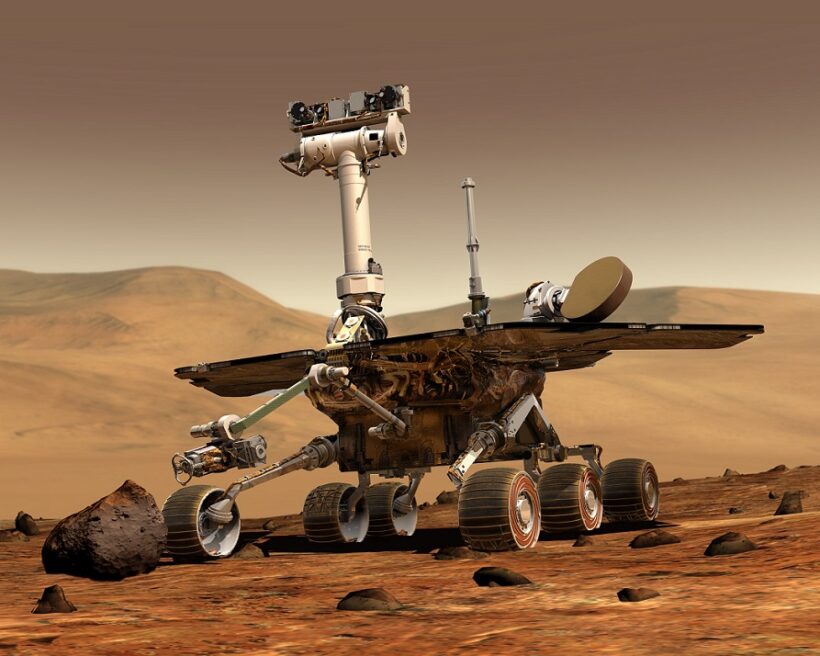Good Night Oppy is the new documentary by Ryan White and presents the missions carried out by the rovers Opportunity and Spirit on Mars. The documentary is produced by Steven Spielberg’s company Amblin Entertainment.
The documentary mixes archival footage of US Space Agency (NASA) engineers working in the field with scenes recreated in the studio.
Oppy (Opportunity) is quite a character, he is the star of the documentary. The NASA-designed rover was originally launched on July 7, 2003 for a 90-day mission, but surprisingly stretched the lifespan of its instruments to 15 years. Spirit, its twin, was launched three weeks ago. Their missions find out if Mars ever harbored water.
Watching the documentary, you almost believe that rovers have intention and emotions. But obviously when we look closer we understand how the intention of engineers and scientists has made its way as they humanized this technology with great care and love.
Oppy as it is affectionately known to scientists and engineers, is a mix of wheels, wires, antennas and solar panels that combine with traits familiar to humans. She has a long neck and carries on her head several cameras spread horizontally in binocular formation like eyes. From the opening scenes, the viewer’s emotions are challenged when the rover stops in front of what she assumes to be a Martian obstruction but turns out to be her own shadow. We can’t help but attribute personality and emotions to it.
The human connection with the rovers appears frequently in the film. In fact, NASA engineers project their own emotions onto the rovers and often portray them as if they were their children. Engineers also tend to explain the Oppy and Spirit incidents on Mars in human terms, such as when a system malfunction or error occurs, they describe it as a cold or pneumonia.
Towards the end of the Oppy rover’s mission, scientists finally discover clues that confirm that part of Mars has already been covered with water.
Humanize “Oppy” and “Spirit”
“These robots are the replacements of those people. Nasa engineers essentially lived vicariously through rovers because they themselves cannot dig into Martian rock. They inevitably project human qualities onto the robot,” explains White. (Source: Guardian)
By humanizing rovers, engineers and scientists have clearly affirmed their intentionality by amplifying human freedom of action. Never before has the human species been able to go to other worlds to study the soils and the atmosphere. By using technologically advanced instruments and sophisticated means of communication which, placed in front of their bodies like external prostheses 225 million kilometers away from the earth and sometimes even 400 kilometers away, scientists have been able to transmit commands to rovers and to study Mars planet. The rovers have allowed them to lengthen their hand and sight and by doing so have increased the good knowledge of all of humanity. It is quite an accomplishment that comes from an intention that resides in the human being for millennia.
In addition, the documentary shows us how the flexibility and adaptability of scientists and engineers were necessary for the success of the mission. Every day, they had to adapt to the Martian conditions: the Martian day, the cold, the winter, the sandstorms lasting several days, even several weeks. The scientists have exceeded their initial mission. It is thanks to the reversibility of consciousness that they were able to constantly adapt this mission and learn unexpected things and go beyond natural determinisms and in a radical way.
In fact, this mission not only teaches us that there was once water on Mars, but gives us very clear clues to affirm loud and clear that the intentionality of the consciousness of the human being does not possess a fixed nature. For the first time in its history, the human species was able via technology to step out of its world and study the otherworldly soil and atmosphere 225 kilometers from its point of origin.
The human species is fantastic, and when it places its intention in the direction of increasing freedom and good knowledge, it does extraordinary things and transforms the world.
________________________________________________________________
Source autoliberation
Intentionality of consciousness: Fundamental mechanism of consciousness, by means of which it maintains its structurality, linking acts to objects. This connection is not permanent and it is what allows the dynamics of consciousness, since the acts are in search of objects.
Reversibility of consciousness: Fundamental mechanism of consciousness. faculty of consciousness to direct itself, by means of attention, towards its sources of information. (senses, memory and evocation).






